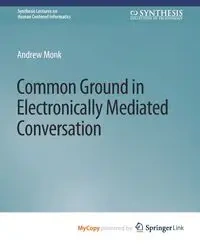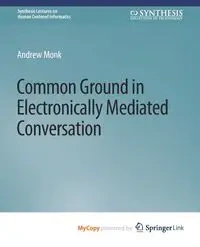Common Ground in Electronically Mediated Conversation - Andrew Monk
Common Ground in Electronically Mediated Conversation - Andrew Monk
AutorzyAndrew Monk
EAN: 9783031033124
Marka
Symbol
029HKG03527KS
Rok wydania
2008
Strony
56
Oprawa
Miekka
Format
19.1x23.5cm
Język
angielski

Bez ryzyka
14 dni na łatwy zwrot

Szeroki asortyment
ponad milion pozycji

Niskie ceny i rabaty
nawet do 50% każdego dnia
Niepotwierdzona zakupem
Ocena: /5
Marka
Symbol
029HKG03527KS
Kod producenta
9783031033124
Rok wydania
2008
Strony
56
Oprawa
Miekka
Format
19.1x23.5cm
Język
angielski
Autorzy
Andrew Monk

Technologies that electronically mediate conversation, such as text-based chat or desktop video conferencing, draw on theories of human−human interaction to make predictions about the effects of design decisions. This lecture reviews the theory that has been most influential in this area: Clark's theory of language use. The key concept in Clark's theory is that of common ground. Language is viewed as a collaborative activity that uses existing common ground to develop further common ground and, hence, to communicate efficiently. The theory (a) defines different kinds of common ground, (b) formalizes the notion of collaborative activity as a "joint action," and (c) describes the processes by which common ground is developed through joint action. Chapter 1 explains why a purely cognitive model of communication is not enough and what is meant by the phrase "collaborative activity." Chapter 2 introduces the idea of common ground and how it is used in language through an example of two people conversing over a video link. Chapter 3 indicates where the interested reader can find out about the antecedents to Clark's theory. Chapter 4 sets out the fundamental concepts in Clark's theory. Chapter 5 uses five published case studies of electronically mediated communication to illustrate the value of the theory. These include studies of a computer-supported meeting room (Cognoter), a video tunnel that supports gaze awareness, video conferencing in medical consultation, and text chat. Table of Contents: Motivation - Conversation as a Collaborative Activity / Overview - Developing Common Ground, An Example / Scientific Foundations / The Theory in More Detail / Case Studies - Applying the Theory to Electronically Mediated Communication / Current Status
EAN: 9783031033124
EAN: 9783031033124
Niepotwierdzona zakupem
Ocena: /5
Zapytaj o produkt
Niepotwierdzona zakupem
Ocena: /5
Napisz swoją opinię

